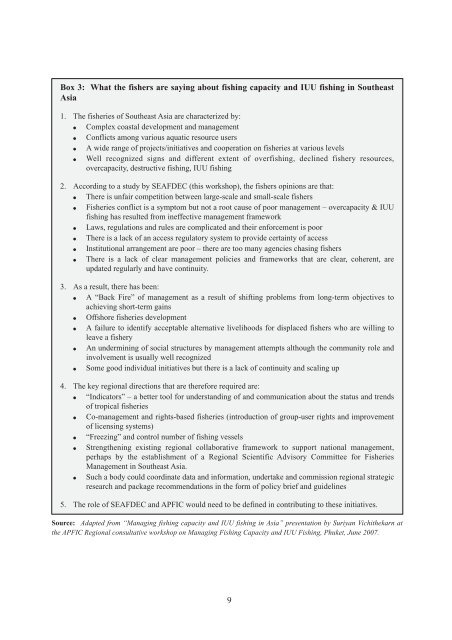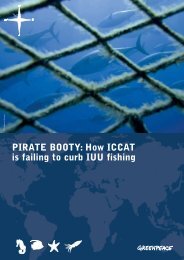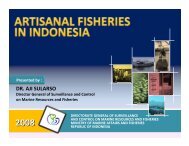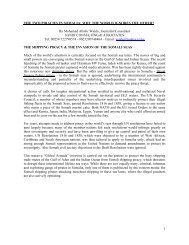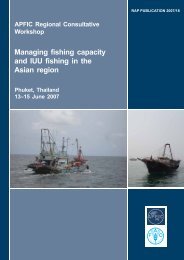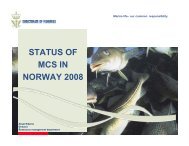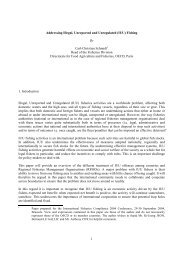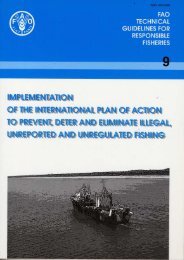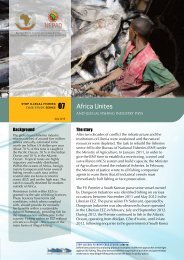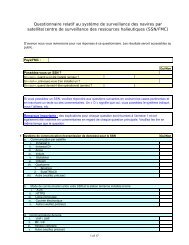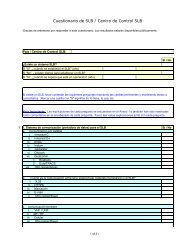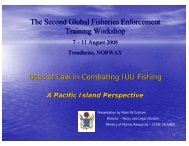Fishing capacity management and IUU fishing in Asia - FAO.org
Fishing capacity management and IUU fishing in Asia - FAO.org
Fishing capacity management and IUU fishing in Asia - FAO.org
Create successful ePaper yourself
Turn your PDF publications into a flip-book with our unique Google optimized e-Paper software.
Box 3: What the fishers are say<strong>in</strong>g about <strong>fish<strong>in</strong>g</strong> <strong>capacity</strong> <strong>and</strong> <strong>IUU</strong> <strong>fish<strong>in</strong>g</strong> <strong>in</strong> Southeast<strong>Asia</strong>1. The fisheries of Southeast <strong>Asia</strong> are characterized by:● Complex coastal development <strong>and</strong> <strong>management</strong>● Conflicts among various aquatic resource users● A wide range of projects/<strong>in</strong>itiatives <strong>and</strong> cooperation on fisheries at various levels● Well recognized signs <strong>and</strong> different extent of over<strong>fish<strong>in</strong>g</strong>, decl<strong>in</strong>ed fishery resources,over<strong>capacity</strong>, destructive <strong>fish<strong>in</strong>g</strong>, <strong>IUU</strong> <strong>fish<strong>in</strong>g</strong>2. Accord<strong>in</strong>g to a study by SEAFDEC (this workshop), the fishers op<strong>in</strong>ions are that:● There is unfair competition between large-scale <strong>and</strong> small-scale fishers● Fisheries conflict is a symptom but not a root cause of poor <strong>management</strong> – over<strong>capacity</strong> & <strong>IUU</strong><strong>fish<strong>in</strong>g</strong> has resulted from <strong>in</strong>effective <strong>management</strong> framework● Laws, regulations <strong>and</strong> rules are complicated <strong>and</strong> their enforcement is poor● There is a lack of an access regulatory system to provide certa<strong>in</strong>ty of access● Institutional arrangement are poor – there are too many agencies chas<strong>in</strong>g fishers● There is a lack of clear <strong>management</strong> policies <strong>and</strong> frameworks that are clear, coherent, areupdated regularly <strong>and</strong> have cont<strong>in</strong>uity.3. As a result, there has been:● A “Back Fire” of <strong>management</strong> as a result of shift<strong>in</strong>g problems from long-term objectives toachiev<strong>in</strong>g short-term ga<strong>in</strong>s● Offshore fisheries development● A failure to identify acceptable alternative livelihoods for displaced fishers who are will<strong>in</strong>g toleave a fishery● An underm<strong>in</strong><strong>in</strong>g of social structures by <strong>management</strong> attempts although the community role <strong>and</strong><strong>in</strong>volvement is usually well recognized● Some good <strong>in</strong>dividual <strong>in</strong>itiatives but there is a lack of cont<strong>in</strong>uity <strong>and</strong> scal<strong>in</strong>g up4. The key regional directions that are therefore required are:● “Indicators” – a better tool for underst<strong>and</strong><strong>in</strong>g of <strong>and</strong> communication about the status <strong>and</strong> trendsof tropical fisheries● Co-<strong>management</strong> <strong>and</strong> rights-based fisheries (<strong>in</strong>troduction of group-user rights <strong>and</strong> improvementof licens<strong>in</strong>g systems)● “Freez<strong>in</strong>g” <strong>and</strong> control number of <strong>fish<strong>in</strong>g</strong> vessels● Strengthen<strong>in</strong>g exist<strong>in</strong>g regional collaborative framework to support national <strong>management</strong>,perhaps by the establishment of a Regional Scientific Advisory Committee for FisheriesManagement <strong>in</strong> Southeast <strong>Asia</strong>.● Such a body could coord<strong>in</strong>ate data <strong>and</strong> <strong>in</strong>formation, undertake <strong>and</strong> commission regional strategicresearch <strong>and</strong> package recommendations <strong>in</strong> the form of policy brief <strong>and</strong> guidel<strong>in</strong>es5. The role of SEAFDEC <strong>and</strong> APFIC would need to be def<strong>in</strong>ed <strong>in</strong> contribut<strong>in</strong>g to these <strong>in</strong>itiatives.Source: Adapted from “Manag<strong>in</strong>g <strong>fish<strong>in</strong>g</strong> <strong>capacity</strong> <strong>and</strong> <strong>IUU</strong> <strong>fish<strong>in</strong>g</strong> <strong>in</strong> <strong>Asia</strong>” presentation by Suriyan Vichithekarn atthe APFIC Regional consultative workshop on Manag<strong>in</strong>g <strong>Fish<strong>in</strong>g</strong> Capacity <strong>and</strong> <strong>IUU</strong> <strong>Fish<strong>in</strong>g</strong>, Phuket, June 2007.9


